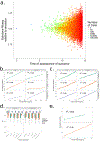Currently available bulk sequencing data do not necessarily support a model of neutral tumor evolution
- PMID: 30374067
- PMCID: PMC6467055
- DOI: 10.1038/s41588-018-0217-6
Currently available bulk sequencing data do not necessarily support a model of neutral tumor evolution
Conflict of interest statement
Conflict of interest:
All authors wrote the manuscript.
Figures



Comment in
-
Reply to 'Currently available bulk sequencing data do not necessarily support a model of neutral tumor evolution'.Nat Genet. 2018 Dec;50(12):1624-1626. doi: 10.1038/s41588-018-0235-4. Nat Genet. 2018. PMID: 30374070 No abstract available.
Comment on
-
Identification of neutral tumor evolution across cancer types.Nat Genet. 2016 Mar;48(3):238-244. doi: 10.1038/ng.3489. Epub 2016 Jan 18. Nat Genet. 2016. PMID: 26780609 Free PMC article.
References
Publication types
MeSH terms
Grants and funding
LinkOut - more resources
Full Text Sources

